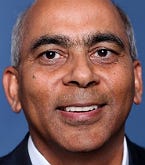'7 Minutes' with Cambium Networks President and CEO Atul Bhatnagar
In our latest edition of '7 Minutes,' Cambium Networks' Atul Bhatnagar talks IoT, open standards and innovation.
September 4, 2017

**Editor’s Note: “7 Minutes” is a feature where we ask channel executives from startups – or companies that may be new to the Channel Partners audience – a series of quick questions about their businesses and channel programs.**
The Internet of Things is a sales boon for Cambium Networks, which provides wireless narrowband and broadband gear and management software through its global partner network. Connecting remote nodes, whether an oil rig, livestock or remote location, plays to Cambium’s history of supporting industrial IoT communications — in fact, the company says it has connected 5.6 million devices to date.
As we’ve discussed, IoT innovations can help partners revolutionize SMBs and branch offices, but only if they can achieve reliable connectivity.

Cambium Networks’ Atul Bhatnagar
While competitors including Proxim, Ruckus and Xirrus might be better known, Cambium President and CEO Atul Bhatnagar, who joined the company in 2013 from Ixia Communications, sees growth potential thanks to growing demand for dependable, affordable backhaul.
Channel Partners: Tell us what customers love about your product or service. What’s the secret selling sauce?
Atul Bhatnagar: Our customers love Cambium’s compelling quality and the durability of the products. The products have been installed all over the world, and they have been working, in many cases, for seven or eight years without any intervention. We have shipped 7 million radios worldwide, connecting about 100 million people in 130 countries. So, that’s one.
The second thing our customers like about our products is that our innovation has enabled a very high degree of affordability, and hence we are able to fulfill our vision of connecting the unconnected: people, places and things. So in summary, what they like about us is affordable, yet compelling quality through cutting-edge innovation.
CP: Describe your channel program — metal levels, heavy on certifications, open or selective, unique features?
AB: The program, as it exists today, has three levels of achievement: authorized, gold and platinum. The levels are primarily determined by sales achievement and are rewarded with upfront discounts at the time of purchase. It is mostly an open system with some selective components for specific vertical markets.
We are different than most of our competitors because of our strong enforcement of MAP and minimum-resale policies. We also offer deal registration for qualified opportunities that can add as much as 12 percent additional margin for some products. These two elements allow our partners to operate in a more predictable margin environment.
CP: Quick-hit answers: Percentage of sales through the channel, number of partners, average margin. Go.
AB: Our channel program is global; 95 percent of our worldwide sales go through a two-tier channel model. Worldwide, we have about 3,200 channel partners, about 300 distributors and 10,000 customers.
Margins scale from 13-27 percent, depending on products and deal registration.
CP: Who are your main competitors, and what makes your offering better?
AB: I would say our differentiation against our competition is three key points.
No.1, our quality is proven with those 7 million radios installed worldwide. Our ability to handle tough terrain and tough weather is proven from +50 Celsius to -50 Celsius, all over the world. We provide 24-by-7 support, and that support of mission-critical network deployments is what customers …
… value the most. And, our affordability through innovation and excellent quality differentiates us from our competition.
Our employees are global and represent about 25 countries. And because of that, we keep a very global perspective when we design products. And that is a key differentiator that customers really like.
CP: How do you think your technology portfolio will change in the next three years?
AB: We are technology-agnostic. We are believers in networking standards and a networking ecosystem where interoperability with standards is highly valued. So, over the next three years, our portfolio will adopt emerging standards.
Secondly, to provide affordability through cutting-edge innovation, we also adopt technologies like Wi-Fi into our product lines. That gives us a cost advantage because the mass manufacturing of these high-performance chips is driving the cost down. We are able to leverage these new technologies and yet provide very innovative solutions. For example, our ability to provide a very high degree of performance in very noisy environments is a key differentiator.
So, our differentiation on standards becomes our ability to handle noise, our ability to handle very tough terrain, very tough weather, and our ability to manage all of our devices on a single pane of glass using the cnMaestro cloud-based management system.
Additionally, over the next three years, our ability to gather analytics and data and provide predictive support will increase significantly.
CP: How do you expect your channel strategy to evolve over that time frame?
AB: In the future, the metal-level achievement will be more certification based, and upfront discounts will be narrowed, but adequate, for run-rate business. Additional margin will be achieved by deal registration and volume rebates. The focus will be on simplicity and removing high administrative costs to run our programs and being easy to do business with.
CP: What didn’t we ask that partners should know?
AB: Partners should know that no one technology will win. It will be multiple technologies co-existing in the networking world. The companies which are able to demystify networking by adopting multiple technologies, and yet focusing on ease of deployment and ease of operation, will really provide customers successful ways to create networks.
Read more about:
AgentsAbout the Author
You May Also Like


